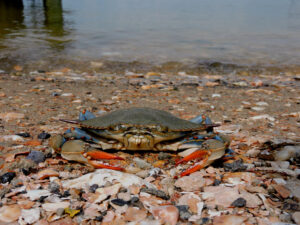
Regulations that focused on female crabs starting in 2008 helped bring a back the population of the iconic crustacean in the Chesapeake Bay. Photo by Stephanie Kendall
In the late 2000s, the outlook for blue crabs in the Chesapeake Bay was grim.
Known for its ups and downs, the blue crab harvest was going through a long stretch of almost all downs. The crab population steeply declined after 1997 and remained at record low harvests for a decade. The region lost nearly 4,500 crab-related jobs between 1998 and 2006.
Determined to save the crabbing industry—the most profitable fishery in the Bay—and increase the population of blue crabs, officials from Maryland, Virginia, and the Potomac River Fisheries Commission took action, enacting a spate of bold regulations that changed the way the species was managed.
In the next few years, blue crabs bounced back. Lynn Fegley, the director of the Maryland Department of Natural Resources Fishing and Boating Services, credits that comeback to the close collaboration between fisheries managers across state lines, and the watermen who took on sacrifices for the future of the fishery.
“It was a bad moment for crabs, but the governors, the states, the watermen, and the crabbing community got together, we all worked together and we turned the needle,” Fegley said.
Now in the shadow of those management decisions from two decades ago, the blue crab fishery today has seen a more stable crab population and harvest. Yet scientists say this moment is another important juncture for blue crabs and their future in the Bay.
Juvenile recruitment—the abundance of young crabs—has been low for five years in a row, and the overall population dipped in 2022. In part to address these and other lingering questions, a new blue crab stock assessment is in the works to assess the population of blue crabs. It’s the first since 2011, which came on the heels of significant management changes at that time.
For Maryland Department of Natural Resources fisheries managers, the new assessment is a chance to look back at the last assessment and related management decisions—both as a model for collaborative management and a foundation to continue to build from.
“The 2011 stock assessment and the management decisions made just prior to that in 2008, that was based on the best data we had then, and that was how we saw the population bounce back. Blue crabs responded really well to that management,” Mandy Bromilow, Maryland DNR’s blue crab program manager, said. “The new assessment is going to build on that framework and bring in the best models, data and science we have now.”
A paradigm shift
The geography and the habitats of the Chesapeake Bay have made it a fitting home for blue crabs. Beds of sea grasses provide foraging and nursery grounds for crabs throughout the Bay, and every summer female crabs, or sooks, venture to the saltier waters of the mouth of the Chesapeake to spawn. Young crabs start their lives in planktonic larval form, adrift in the coastal Atlantic Ocean, only to return after many molts.
These arthropods have short lifespans, subject to the whims of temperatures, currents and other environmental factors. As a result, the crab fishery has always fluctuated, and crabbers grew accustomed to cycles of higher and lower harvests. Even with these boom and bust periods, the fishery was able to adapt to fluctuations, and regulations on crabbing were mostly limited to restrictions on gear and time.
The downward cycle that started in 1998 was unprecedented for the fishery. The population fell by 63% percent between 1990 and 2008. Even with lower harvests than earlier years, the science from fisheries biologists suggested that the blue crabs were being overharvested, a fateful combination that stopped the population from recovering.
In a 2007 document, Fegley — then Maryland DNR’s blue crab project manager and chair of the Chesapeake Bay Stock Assessment Committee — wrote: “We have not experienced this particular stock status of low adults, low recruitment and high exploitation rates within our recorded history of the crab fishery.”
In 2007, the winter dredge survey, Maryland and Virginia’s annual estimate of the total blue crab population in the Bay, turned up a historic low at the time of only 251 million crabs. A year later, the U.S. Department of Commerce would issue a disaster declaration for the fishery.
The Maryland Department of Natural Resources, the Virginia Marine Resources Commission, and the Potomac River Fisheries Commission agreed to implement regulations that would result in a 34% reduction in the harvest rate of female blue crabs.
As is the case with many animals, females are a limiting factor for reproduction in blue crabs. Males can mate with multiple females, and a relatively lower male population can still support a healthy recruitment year.
In a quirk of their biology, female blue crabs only have one opportunity to mate, during their last molt. They can spawn multiple times from a single pairing, which means that mature female blue crabs are essentially always pregnant, and each one caught is a potential spawner.
“We wanted to get those female crabs safe passage into Virginia where they spawn,” Fegley said this June.
In 2008, Bay-wide regulatory changes started to take effect. Maryland shortened the crabbing season, implemented female bushel limits, and limited the number of participants in the culturally and economically important fall sook run, where the fishery targets pre-spawn females on their southward migration.
Virginia shortened its season for female crabs and closed its winter dredge fishery, a technique previously banned in Maryland where a toothed dredge drags across the bottom to pull up dormant crabs. The Virginia Marine Resources Commission suggested the practice cut up and destroyed half or more of the crabs targeted, and in Virginia it was used on populations of pre-spawn female crabs.
VMRC Commissioner Steven Bowman said at the time the ban and additional regulations were necessary “to prevent a potential collapse” of the population of blue crabs, the Associated Press reported.
Because blue crabs, particularly females, move through the entire Bay over the course of their life cycle, Bay-wide coordination of management is critical to ensure adequate protections of the stock, Fegley said. Prior to 2008, Maryland and Virginia tended to manage independently and the respective management programs were not protective enough for the migrating female component of the stock.
Fegley described the collaboration between Maryland and Virginia that began in 2008 as critical to successfully bringing the crabs back.
“It’s all one resource. It’s one population spread across two states,” she said. “The fact that everybody went together the way that they did—that’s what did it.”
It took time to adjust the regulations, but the states worked with the input of crabbers, Fegley said. The new regulations were difficult sacrifices for the crabbing community, but they made the long-term survival of the fishery possible.
In 2011, a team of researchers led by the University of Maryland Center for Environmental Science released a stock assessment that laid out new benchmarks for the blue crab population. The assessment established female-specific reference points for sustainable yield.
After a few years of the new management strategy, the states started to see results. In 2012, the blue crab population hit a 19-year high of 764 million. Crabs were abundant again—and scientists attributed the return to the changes in the management of the fishery.
“It’s one of the most successful fishery stock rebuilding programs ever, anywhere,” Douglas Domenech, Virginia’s then-secretary of natural resources, said in 2012.
Lingering questions
The management strategy that brought the Chesapeake’s blue crabs back from the brink has largely remained the same since that time, with some updated reference points and minor adjustments to harvest limits based on results of the annual winter survey.
But there have been some warning signs that suggest additional changes might become necessary. In 2022, the winter dredge survey estimated only 227 million crabs in the Bay, even fewer than 2007’s historic low. Then, the 2024 survey marked the fifth consecutive year of below-average recruitment.
These results inspired the Chesapeake Bay Stock Assessment Committee to explore the pursuit of another benchmark stock assessment. Preliminary data analysis begins this summer, and the assessment is set to be completed and published in March 2026.
The new stock assessment will revisit assumptions of the 2011 assessment and bring new modeling techniques to the data. It will also consider factors that have changed in recent years, such as environmental influences and predation by blue catfish.
“The science has gotten better,” Mike Luisi, DNR Fishing and Boating Services Tidal and Coastal Management and Science Branch director. “It leads to more precision in how we manage.”
One consideration will be whether male-specific benchmarks should be established in addition to the female benchmarks. Though female blue crabs are the greater limiting factor for reproduction, Bromilow said it’s possible there are areas with so few males that some females don’t have a chance to mate during their limited window.
Though some have suggested the annual winter dredge survey could be underestimating juveniles, Fegley said the juveniles measured by the survey have been a good predictor of the upcoming harvest, which suggests the survey estimates are an accurate representation of the number of young crabs.
“Juvenile abundance estimates are still the best indicator of population health that we have,” said Glenn Davis, a DNR fisheries biologist who conducts data analysis on blue crabs. “So we need to look at what has changed since 2009 to 2016. Why are we not getting the same results despite robust numbers of over-wintering females?”
Luisi said the 2011 stock assessment was essential to the proceeding years of management, and the new assessment will build on the previous one and will similarly help to guide the upcoming years of management.
“Going by the science put crabs back on track in the 2010s,” he said. “Now we need to look to the science again to make sure we’re effectively managing blue crabs for a sustainable fishery.”
By Joe Zimmermann, science writer with the Maryland Department of Natural Resources
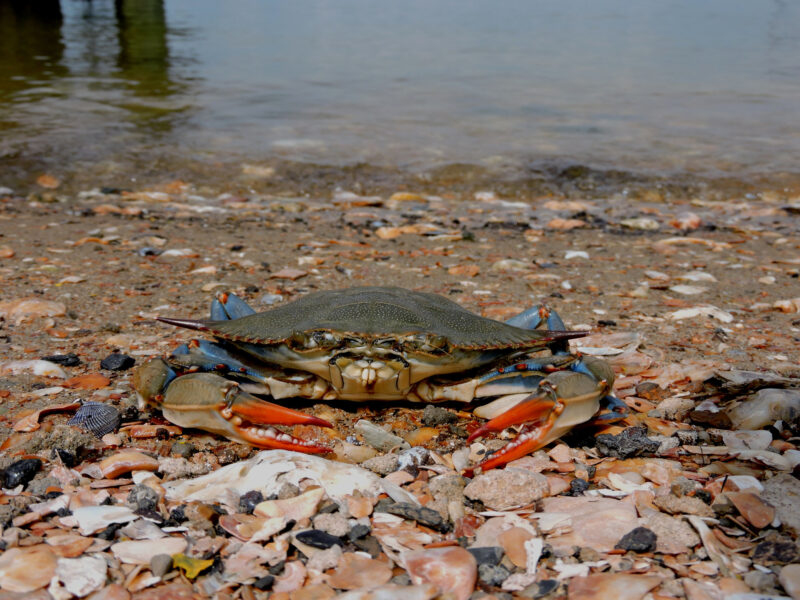
Regulations that focused on female crabs starting in 2008 helped bring a back the population of the iconic crustacean in the Chesapeake Bay. Photo by Stephanie Kendall

The Chesapeake Bay blue crab harvest, adjusted for changes in reporting methods, between 1945 and 2006. Pink lines indicate the mean harvest during periods subjectively determined to be high or low harvest levels, with the period starting at 1998 representing a stretch of the lowest years on record. DNR
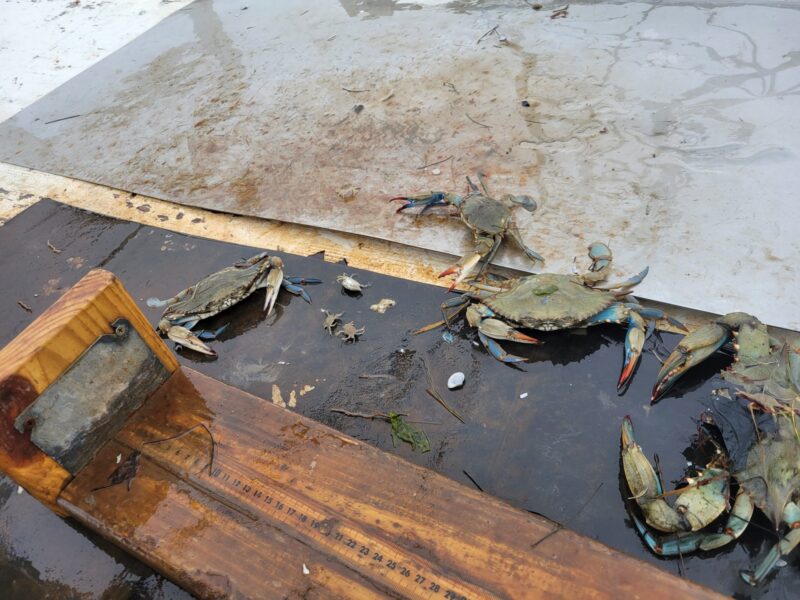
Juvenile and adult blue crabs are measured during the 2024 winter dredge survey. Photo by Joe Zimmermann
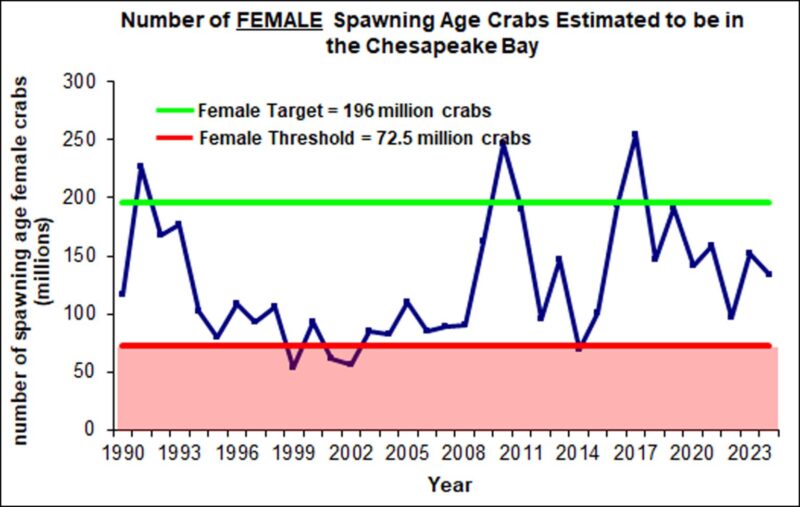
Since establishing female-specific benchmarks, the population of female blue crabs has increased. DNR
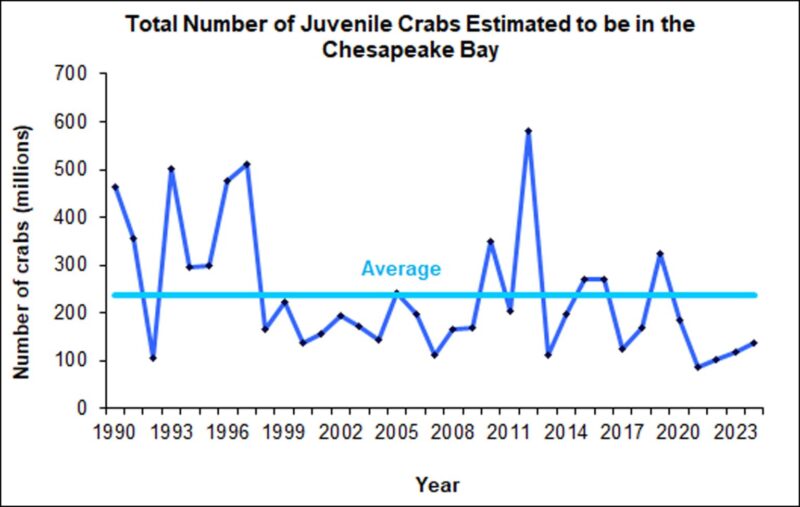
Despite the stable population of female adult crabs, the population of juveniles has been below average for five consecutive years. DNR


